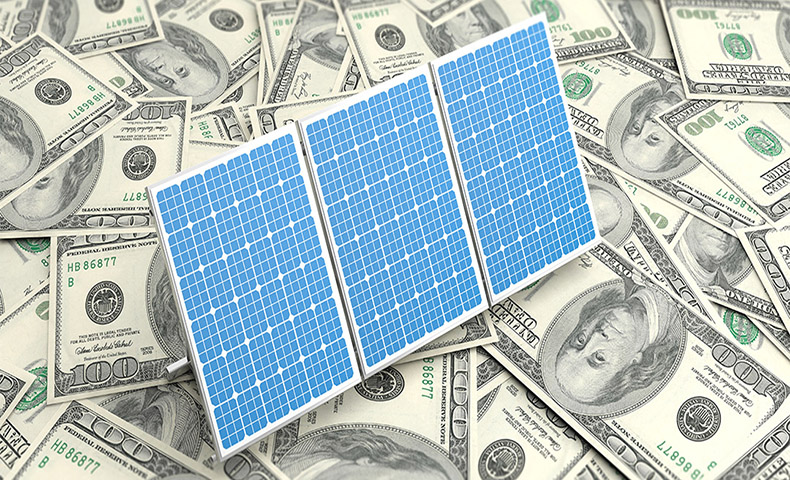
If you make an investment, you want to know when you’ll recuperate that initial cost.
Prices of solar panels are no different. You’re making a decision to buy them and the rest of the solar power system equipment with the intent of recuperating that money through the savings you’ll get in your electric bill.
But figuring out when you’ll reach ROI (Return on Investment) depends not only on how much solar panels cost when your purchase them, but also the cost of the installation, what size of a domestic solar power system will be mounted on your home’s roof and the number of sun peak hours in your region.
They all combine for a formula that is not exact science.
Richard Cox, who studied Electrical and Electronics Engineering at California State Polytechnic University in Pomona, gives an example of such a calculation on an Internet message board devoted to solar power.
“I bought a system 3 years ago. Nameplate rating is 5.2 KW, but the best it does is about 4.5. 14 panels are on a South facing roof, and 4 on an East facing. We have central air condition and use it a lot in the summer. Our summer bill used to be more than $300, and $100 to $150 in winter. Our annual cost was about $2500,” he details.
“After the system was installed, out cost is now about $600/year. Given the cost of the system after rebate was around $11,000, the payback is under 6 years, and the value of the property is increased by about $15,000.”
“I am very happy with the investment,” he concludes.
The size of the system
One of the determining factors for calculating ROI is the size of the system and how much of the electric grid power you’re offsetting with it in an annual basis.
This can be easily factored through the Hahasmart price checker that will provide you with the correct size of your solar power system. Just provide your address and your average monthly utility bill and you’ll get the actual price of solar panels and inverters - which are the most critical parts of a solar powered system - as well as provide you with an estimated cost of installation based on thousands of completed solar projects in your area.
They’ll even provide you with an estimated buyback period, the point where the electricity savings achieved with your solar array cover the purchase of your residential solar panels and your system becomes free.
In addition, they’ll connect you with their installer network to get your residence equipped with solar power as possible.
Cash or credit?
Another factor to consider is whether you will pay out of pocket for your home solar energy system or you are taking out a loan to cover the cost.
“If the system is financed, what is the applicable interest rate and what is the total cost going to be? If it's a cash deal, chances are that cash came out of an interest bearing account, so loss of interest is also a factor to consider, over the lifetime of the system,” notes General Manager Nicholas Boshoff.
“My 12.7 KW system for which I paid cash about 8 years ago paid off in 4 years. Pretty much free electricity now. And since I have a well, water is also free,” saysw Patrick Harvey, a former Software Manager at Arizona Instrument.
Net Metering
If the utility in your area offers net metering, that will also be a factor on how soon you can make back your investment. If you’re sending large amounts of excess power to the grid during the day in comparison with how much you get from it at night, the company will owe you money at the end of the year.
Or maybe you’re achieving net zero energy, covering all the electricity you get from the utility with the energy you send to it. In either case, you’re electric bill will only be a few dollars a month for connection and maintenance fees.
When you tap into sunshine for energy, you’ll also be avoiding the ever increasing cost of electricity, so that’s an added bonus in this calculation.
Incentives
The incentives, tax credits and exemptions available in your area also play a role in your ROI, as they can discount hundreds (if not thousands) of dollars from the costs for solar panels.
On average, people who turn to solar power for their energy needs will recuperate their investment in 6-8 years. But the working life of a domestic solar power system is estimated between 20-25 years, so you’ll be enjoying free electricity for nearly two decades. Anything free for that long of a time has a great ROI.
HahaSmart Blog - More Solar Tips and Guide
HahaSmart News - Stay Informed
Your Solar Incentives - See Credits and Incentives in Your Area
Check Your Home's Solar Price - See How Much You Save
Register Now - Unlock The Lowest Solar Prices in Your Area


Input your address to see if it is solar friendly and how much you can save with solar.
Great. Your address is perfect for solar. Solar incentive is still available. Select monthly utility cost and calculate the size of solar system you will need now.
| kw System size | years Payback period | Lifetime savings |
No money down, 100% finance is available.
|
|
Sign up to learn more about home solar panel costs, see quote right away |
Comments